Defining The
Generations Of Videogaming
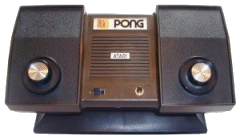 1. The Pong Generation (early to
late 1970s) -- which brought forth the introduction of
videogaming in general to the American public, both in the
arcade and in the home. Ralph Baer's experiments with
broadcasting images from a computer board to a television became
successful enough to be used in the first videogame system
produced for the home market, the Magnavox Odyssey, which used
plastic screen overlays to supplement the rather crude graphics
of the system's built-in games. Nolan Bushnell used the
technology to develop the first arcade-based videogames,
Computer Space and Pong. The first game Computer
Space became a flop because it was too advanced of a game
for its time, but its follow-up Pong became such a
sensation that it inspired other similar games like Breakout
and Circus by Exidy. The company Atari was born
from the success of Pong, and eventually other companies
would be birthed either from out of nowhere or from the existing
manufacturers of pinball games, such as Bally's Midway, to
develop other arcade games. Self-contained game systems
that played variations of Pong and other sorts of games
that emerged in this generation would flood the market by the
mid-1970s.
1. The Pong Generation (early to
late 1970s) -- which brought forth the introduction of
videogaming in general to the American public, both in the
arcade and in the home. Ralph Baer's experiments with
broadcasting images from a computer board to a television became
successful enough to be used in the first videogame system
produced for the home market, the Magnavox Odyssey, which used
plastic screen overlays to supplement the rather crude graphics
of the system's built-in games. Nolan Bushnell used the
technology to develop the first arcade-based videogames,
Computer Space and Pong. The first game Computer
Space became a flop because it was too advanced of a game
for its time, but its follow-up Pong became such a
sensation that it inspired other similar games like Breakout
and Circus by Exidy. The company Atari was born
from the success of Pong, and eventually other companies
would be birthed either from out of nowhere or from the existing
manufacturers of pinball games, such as Bally's Midway, to
develop other arcade games. Self-contained game systems
that played variations of Pong and other sorts of games
that emerged in this generation would flood the market by the
mid-1970s.
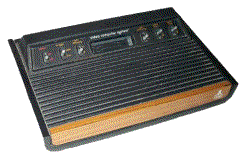 2. The Atari
Generation Part I (late 1970s to early 1980s) -- came
about with the introduction of both the Atari 2600 Video
Computer System and Taito's arcade game Space Invaders,
both of which redefined video games in their own ways. The
Atari 2600 would introduce and popularize the concept of game
systems that would use interchangeable game programs contained
in cartridges, while Space Invaders brought forth a much
more modernized concept of gaming such as increasing challenge
with each new screen to conquer in addition to having only a few
lives to play a game with. These changes would inspire a
new generation of both arcade games and videogame systems that
would explore the possibilities inherent thereof. Atari's
Asteroids would use a different kind of video technology
as it would present a different kind of space game taking place
in a zero-gravity setting, allowing for more freedom of movement
than Taito's Space Invaders. Namco's Pac-Man
would introduce the "mascot game" where a familiar face would
become a flagship character associated with its parent company
(Midway for the American audiences) as it would spawn multiple
sequels featuring variations of both its character and its
gameplay.
2. The Atari
Generation Part I (late 1970s to early 1980s) -- came
about with the introduction of both the Atari 2600 Video
Computer System and Taito's arcade game Space Invaders,
both of which redefined video games in their own ways. The
Atari 2600 would introduce and popularize the concept of game
systems that would use interchangeable game programs contained
in cartridges, while Space Invaders brought forth a much
more modernized concept of gaming such as increasing challenge
with each new screen to conquer in addition to having only a few
lives to play a game with. These changes would inspire a
new generation of both arcade games and videogame systems that
would explore the possibilities inherent thereof. Atari's
Asteroids would use a different kind of video technology
as it would present a different kind of space game taking place
in a zero-gravity setting, allowing for more freedom of movement
than Taito's Space Invaders. Namco's Pac-Man
would introduce the "mascot game" where a familiar face would
become a flagship character associated with its parent company
(Midway for the American audiences) as it would spawn multiple
sequels featuring variations of both its character and its
gameplay.
The marketing of videogame
systems that would play different games through interchangeable
cartridges would actively target specific kinds of gaming
audiences in this time period, with the Atari 2600 as the
"arcade-action" player's kind of system and the Intellivision
having George Plimpton shilling its strengths as a
sports-playing game system. The fact that both Atari and
Mattel would use licensed properties behind both their series of
games would help attract the kind of consumers that they were
aiming for in the first place.
Personal computers at this
point were in their infancy, but companies such as Atari, Apple,
Commodore, IBM, and Tandy were in the process of developing such
for home use. The British-based Sinclair Technologies
would bring forth the Sinclair ZX81 (the Timex/Sinclair 1000)
that would be the first truly-affordable personal computer
system that could be had for less than $200.
Handheld electronic games
began to crop up in this generation, with Coleco and Mattel's
adaptations of sports games being the most popular. Milton
Bradley released the first programmable handheld system, the
MicroVision, in 1979.
By the tail end of this age,
third-party software support for videogame systems would emerge
as Activision and Imagic began making cartridges for the Atari
2600 and Intellivision outside the control of the parent
hardware companies behind the systems, much to the chagrin of
Atari who took Activision to court over publishing games in such
a fashion and lost the case. Also birthed in the formation
of Activision and Imagic was celebrity recognition of
programmers who developed the games in the first place; although
nowadays game programs would require a whole software design
firm of programmers, sound engineers, graphic designers, and
what-not in order to develop a single game from conception to
finished product, there would still be figureheads such as
Shigeru Miaymoto of Nintendo and John Romero of Doom and
Quake fame (and also of the infamous Daikatana)
who would be recognizable as individual stars behind the games.
On that same note, the "Easter
egg" (the hidden trick embedded in the game that would hide an
interesting surprise for the die-hard gamer to discover) made
its first appearance in this generation through Atari programmer
Warren Robinnett hiding his name in a special room in the Atari
2600 game Adventure. Eventually gamers
discovered how this "Easter egg" was found and spread its news
to all other gamers. Atari eventually allowed its
programmers to embed "Easter eggs" in their games. From
there on, other kinds of "Easter eggs" would appear in all sorts
of games, allowing for all sorts of other tricks, including
those that could alter the gameplay. One of the most
famous is the "Konami code" that would appear in various
Nintendo system games released by Konami.
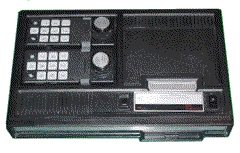 3. The Atari Generation Part II (early 1980s to
1984) -- was a short-lived period that saw a technological
maturation in the home videogaming arena where companies such as
Coleco and Atari offered game systems that would bring
arcade-quality gaming home in the form of the ColecoVision and
the Atari 5200, respectively. Also in that period came
"multi-platform publishing" of games across various game systems
and personal computers, even from companies that sold competing
hardware for the software.
3. The Atari Generation Part II (early 1980s to
1984) -- was a short-lived period that saw a technological
maturation in the home videogaming arena where companies such as
Coleco and Atari offered game systems that would bring
arcade-quality gaming home in the form of the ColecoVision and
the Atari 5200, respectively. Also in that period came
"multi-platform publishing" of games across various game systems
and personal computers, even from companies that sold competing
hardware for the software.
Personal computers would
become an increasingly viable alternative to buying videogame
systems as companies such as Atari, Commodore, Texas
Instruments, and Tandy would market them as "must-haves" for
families who would want computers for doing everything useful in
the household in addition to playing games. Game companies
would also try to offer upgrades to their systems that would
allow owners to turn their game consoles into personal
computers, such as Coleco's Adam and Mattel's Entertainment
Computer System for the Intellivision.
Backwards compatibility would
have its birth in this generation, with Coleco, Atari, and
Mattel selling adapters for playing Atari 2600 games on other
systems, and Atari developing its Atari 7800 Pro System which
would allow its 2600 games to play on that system without an
adapter.
Videogames at this point have
entered the mainstream: with videogame magazines such as Electronic
Games publishing monthly information about the hobby and
industry in general; with comicbooks such as Atari Force
by DC Comics; with movies such as Tron, WarGames,
and The Last Starfighter as well as games based on
movies such as Star Wars and Raiders Of The Lost Ark;
with cartoon shows featuring game characters from Pac-Man,
Donkey Kong, Q-Bert, and Pitfall!; with
"Pac-Man Fever" by Buckner & Garcia becoming a Top 40 pop
music hit; and last but not least, with all sorts of
merchandising that would make a dedicated fan's home or room
into a shrine of worship.
Coleco, Tomy, Entex, Mattel,
Tiger, and Nintendo would be the most prolific among companies
that produced handheld and portable games based on existing
arcade games during this generation, with Coleco pulling out all
the stops in making their adaptations mimic the very look of the
machines that the original games had played in. Entex
would release the short-lived and not-well-supported portable
programmable system called the Adventure System that would play
four different arcade-action games, while GCE through Milton
Bradley would deliver Vectrex, which used "vector-scan" graphics
and would end up being the most highly sought-after system long
after its short market run.
The arcades got a new form of
videogame technology in the form of laserdisks that would be
used for the first stream of full-motion video games released in
the arcades such as Dragon's Lair, Astron Belt,
and M.A.C.H. 3. While this would entertain the
masses for some time, they would also be subject to problems
that not only rendered them inoperable, but would in the end
cause few arcade game companies and operators to have anymore
faith in them.
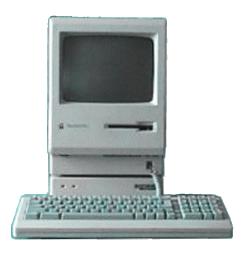 4. The Crash (1984 to 1985) --
was the short period between the Atari Generation Part II and
the Nintendo Generation when the American home gaming market
fell to pieces. Lost profits from a glut of games with no
quality control present was one of the primary reasons for this
to happen, although another was that the American public simply
saw videogames as a passing fad and that time period being a
transitioning phase to embrace personal computers.
Companies that once dealt in videogames and game consoles either
went out of business or shifted their marketing strategies
toward personal computer hardware and software. Even
computer companies with their respective personal computer
systems were dying off, leaving only Atari, Apple, Commodore,
IBM, and Tandy as active players. The Apple Macintosh, the
Commodore Amiga, and the Atari ST would emerge in those
troublesome times as the computers that would set the stage for
those that would follow in the coming generations.
4. The Crash (1984 to 1985) --
was the short period between the Atari Generation Part II and
the Nintendo Generation when the American home gaming market
fell to pieces. Lost profits from a glut of games with no
quality control present was one of the primary reasons for this
to happen, although another was that the American public simply
saw videogames as a passing fad and that time period being a
transitioning phase to embrace personal computers.
Companies that once dealt in videogames and game consoles either
went out of business or shifted their marketing strategies
toward personal computer hardware and software. Even
computer companies with their respective personal computer
systems were dying off, leaving only Atari, Apple, Commodore,
IBM, and Tandy as active players. The Apple Macintosh, the
Commodore Amiga, and the Atari ST would emerge in those
troublesome times as the computers that would set the stage for
those that would follow in the coming generations.
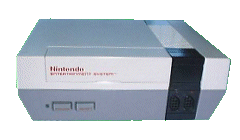 5. The Nintendo
Generation (1985 to late 1980s) -- saw what could be
termed "The Great Videogame Revival" as two arcade game
manufacturers, Nintendo and Sega, brought the hobby and industry
back to life in America with the NES and Sega Master
System. The systems and the games that eventually were
made for them would help prove to America that videogaming was
more than a fad or a transitional stage to using computers; it
was a way of life. Just as merchandising related to
videogames of the early 1980s erupted back then, with prominent
characters such as Pac-Man and Donkey Kong
being primary cash cows in that regard, similar merchandising
would revolve around games made for the NES and characters like
Mario and Legend Of Zelda's Link. Books and
magazines would again be written about videogames of this new
generation. Movies like The Wizard would again
spread the message of the joys of videogaming, which would lead
into the 1990s glut of movies based on videogame titles such as
Super Mario Bros. and Mortal Kombat.
5. The Nintendo
Generation (1985 to late 1980s) -- saw what could be
termed "The Great Videogame Revival" as two arcade game
manufacturers, Nintendo and Sega, brought the hobby and industry
back to life in America with the NES and Sega Master
System. The systems and the games that eventually were
made for them would help prove to America that videogaming was
more than a fad or a transitional stage to using computers; it
was a way of life. Just as merchandising related to
videogames of the early 1980s erupted back then, with prominent
characters such as Pac-Man and Donkey Kong
being primary cash cows in that regard, similar merchandising
would revolve around games made for the NES and characters like
Mario and Legend Of Zelda's Link. Books and
magazines would again be written about videogames of this new
generation. Movies like The Wizard would again
spread the message of the joys of videogaming, which would lead
into the 1990s glut of movies based on videogame titles such as
Super Mario Bros. and Mortal Kombat.
However, unlike the Atari
Generations, Nintendo and Sega got smart about how they wanted
third-party software support for their systems. Nintendo
pioneered the use of a third-party licensing system that would
help stem the control of the amount and quality of games being
released for their NES. They even went so far as to put a
lockout chip in their system to prevent "unauthorized games"
from running on it, although it didn't stop ingenious
programmers from companies such as Tengen and Color Dreams from
"reverse-engineering" the NES to find a way to circumvent this
protection. Sega, on the other hand, simply forbade third-party
companies from releasing games under their own labels, instead
choosing to have them be released under the Sega banner.
However, Nintendo's licensing system put such a strangehold as
far as doing cross-ports of games that would appear on other
systems in addition to the NES until the early 1990s.
Consumers themselves got smart
about how they purchased their games, through the emerging
market of videogame rentals that appeared in the also-emerging
market of video cassette movie rental places in the late
1980s. This "try before you buy" strategy, which started
off with NES games in this generation, would enable even
budget-minded game system owners to enjoy all that's being
offered by game developers and manufacturers without making such
a heavy commitment to own the game first. Some games even
ended up being available as "rental-only" exclusives.
The arcades, meanwhile, would
progress further using 16-bit technology in their games.
The fighting games that had their infancy in The Crash would
later inspire this generation's games such as Double Dragon
and the next generation's Street Fighter II and Mortal
Kombat.
IBM PC clones would infiltrate
the market at this point, yet those who would use them would
have to deal with the rather ridiculous DOS system in order to
run games and other kinds of software on them. Alternate
operating systems would be in the works, though it would be
years before Microsoft's answer to Apple Macintosh's
point-and-click user interface, Windows, would surface in a form
and with a functionality similar to that of its inspiration.
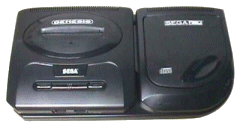 6. The 16-Bit Generation (late
1980s to mid-1990s) -- got its start with Sega jumping the
gun ahead of Nintendo through the release of the Genesis system
two years before the Super NES, and through NEC making its
attempt to break into the market with its TurboGrafx-16.
All three of these systems would show forward-thinking progress
with graphics and sound capabilities that surpassed what the
previous generation of game systems could come up with, while
only two of them, the Genesis and the TurboGrafx-16, would go
further by introducing CD-ROM attachments that would bolster the
amount of memory the system could read in order to create bigger
and (hopefully) longer-playing games. Unfortunately, they
would end up being mostly used for full-motion video games that,
for one, are not suited for the technology of the time and, for
another, would wind being just as repetitive to play and less
interactive as their predecessors in the arcade nearly a decade
ago.
6. The 16-Bit Generation (late
1980s to mid-1990s) -- got its start with Sega jumping the
gun ahead of Nintendo through the release of the Genesis system
two years before the Super NES, and through NEC making its
attempt to break into the market with its TurboGrafx-16.
All three of these systems would show forward-thinking progress
with graphics and sound capabilities that surpassed what the
previous generation of game systems could come up with, while
only two of them, the Genesis and the TurboGrafx-16, would go
further by introducing CD-ROM attachments that would bolster the
amount of memory the system could read in order to create bigger
and (hopefully) longer-playing games. Unfortunately, they
would end up being mostly used for full-motion video games that,
for one, are not suited for the technology of the time and, for
another, would wind being just as repetitive to play and less
interactive as their predecessors in the arcade nearly a decade
ago.
Programmable handheld gaming took off big
time in the 16-Bit Generation, with
the Nintendo Gameboy system and the Atari Lynx being its
pioneers, offering in miniature what the home systems and
arcades had offered with similar quality. Sega and NEC
would join in with their entries into this market, the Game Gear
and the TurboExpress.
Polygon-driven graphic
technology that would become the main staple of videogame
systems to come would have its infancy in the 16-Bit
Generation. On game systems, Nintendo brought forth Starfox
for the Super NES. In the arcades, Atari Games gave us Hard
Drivin', and Sega would deliver Virtua Racing and
Virtua Fighter. On computers, id Software would
produce Doom, an updated version of Wolfenstein 3D.
Atari, the former giant of
home gaming, would have its last attempt of recapturing its
share of the market that they lost to Nintendo and Sega with its
purportedly 64-bit Jaguar system.
The short-lived "multimedia
entertainment system" craze would be part of this generation
when systems that were dubbed such, like the Panasonic/Goldstar
3DO, the Commodore CDTV, and the Philips CD-i, would make the
attempt of offering devices that would do everything short of
being like a personal computer yet would also play games.
Unfortunately, very few people bought into this idea, industry
giants and consumers alike; part of the reason was that it was
an idea years ahead of its time (the DVD technology for playing
movies off disks no bigger than CDs was most likely still in
development), yet the primary reason among gamers was that they
offered very little in the form of games, and even less that
were enjoyable.
The Entertainment Software
Ratings Board system would come at the tail end of this
generation when concerned parents and congressmen would speak on
the issue of graphic violence being realistically portrayed in
videogames. Midway's Mortal Kombat, one of the
games that inspired the creation of the ESRB, would see two
different kinds of conversions when it was first released on
videogame systems by Acclaim: the Super NES version would
replace blood spews with sweat and would change half of its
finishing moves to be less gruesome to watch, while the Genesis
version kept them intact, yet hidden behind a
controller-accessible code that must be entered.
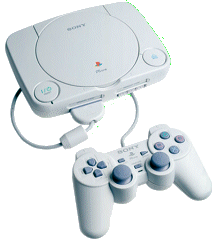 7. The Playstation
Generation (mid- to late 1990s) -- saw another
technological jump, both from using cartridges to using CD-ROMs
as the main source of gaming storage, and from flat 2D "sprite"
images to 3D-rendered polygons. Sega and Sony went into
this generation with the systems that would use both
technologies, the Saturn and the Playstation, while Nintendo
balked at the idea of using CD-ROMs due to perceived piracy and
instead resorted to cartridges for their Nintendo 64.
Square, the role-playing videogame developer for Nintendo's
systems, would end up releasing Final Fantasy VII for
the Playstation instead of the Nintendo 64, using that system's
strengths to its advantage. Undaunted by the loss,
Nintendo upgraded its long-running Super Mario and Legend
Of Zelda game series to being full-fledged 3D adventures
while improving on the emerging first-person shooter category
with an adaptation of MGM/UA's Goldeneye from the James
Bond series of movies.
7. The Playstation
Generation (mid- to late 1990s) -- saw another
technological jump, both from using cartridges to using CD-ROMs
as the main source of gaming storage, and from flat 2D "sprite"
images to 3D-rendered polygons. Sega and Sony went into
this generation with the systems that would use both
technologies, the Saturn and the Playstation, while Nintendo
balked at the idea of using CD-ROMs due to perceived piracy and
instead resorted to cartridges for their Nintendo 64.
Square, the role-playing videogame developer for Nintendo's
systems, would end up releasing Final Fantasy VII for
the Playstation instead of the Nintendo 64, using that system's
strengths to its advantage. Undaunted by the loss,
Nintendo upgraded its long-running Super Mario and Legend
Of Zelda game series to being full-fledged 3D adventures
while improving on the emerging first-person shooter category
with an adaptation of MGM/UA's Goldeneye from the James
Bond series of movies.
In this generation came the
wonders of game emulation programs that talented programmers
would develop, not only for personal computers but also for game
systems, that would allow owners of such systems to enjoy
yesterday's greatest games from the various systems and
computers that they would be played on. As the videogame
industry eventually got its own show called the Electronic
Entertainment Expo (E3) after being part of the Consumer
Electronics show for years, classic videogaming would get its
own show that would be called Classic Gaming Expo (CGEX) that
would not only allow retro-gamers to revisit the glory years of
the hobby, but would also showcase new games developed for the
older systems as well as never-before-seen prototypes of
finished and unfinished games.
The Internet would become
increasingly popular for the gaming industry in general as
gameware manufacturers would use it not only to show their
up-and-coming games but to also let players download demos of
those games. The gaming media would also use the Internet
increasingly as well to review the games that consumers would
want to buy or avoid. And gamers would turn to the
Internet increasingly for online gaming with their friends.
The Pokemon series of
games, birthed from both role-playing videogames of the past and
from the Magic: The Gathering card game of the
mid-1990s, emerged in this generation to help bolster the sales
of the Nintendo Gameboy as the system itself would see the first
of several upgrades which include the Gameboy Pocket, the
Gameboy Color, and in the generation to come, the Gameboy
Advance and the Gameboy Advance SP.
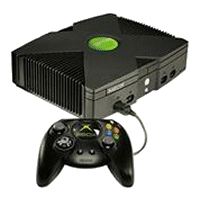 8. The X-Box Generation (late
1990s to circa 2005) -- saw both graphical improvements in
the 3D gaming pioneered by its previous generation and the
switch from using CD-ROMs to DVD-ROMs in three of the four game
systems that were released: the Dreamcast, the Playstation 2,
the X-Box, and the Gamecube. The systems would also make
online gaming, only touched upon by the Super NES and the
Genesis through the X-Band modem, much more commonplace.
8. The X-Box Generation (late
1990s to circa 2005) -- saw both graphical improvements in
the 3D gaming pioneered by its previous generation and the
switch from using CD-ROMs to DVD-ROMs in three of the four game
systems that were released: the Dreamcast, the Playstation 2,
the X-Box, and the Gamecube. The systems would also make
online gaming, only touched upon by the Super NES and the
Genesis through the X-Band modem, much more commonplace.
The self-contained videogame
system that was part of the Pong Generation and had died out
with the advent of the Atari 2600 made a comeback in this
generation, with companies like Jakks Pacific re-releasing Namco
arcade games and Atari 2600 games contained within a system no
bigger than a game controller.
However, the X-Box Generation
would see an exodus of arcade manufacturers leaving the business
to focus mostly on home game entertainment. Atari Games,
which became part of Midway at that point, would close its doors
forever, and Midway would also say goodbye to the amusement
centers that they have been filling games with for years.
What few manufacturers were left to develop arcade games were
now struggling to come up with something to keep people
interested in using up their pocket change to play. Dance
Dance Revolution by Konami would be the only innovative
thing to emerge in the arcades in that generation.
In handheld gaming, Nintendo
replaced its Gameboy series of systems with the Nintendo DS
series, introducing touch-screen gaming with interchangeable
games at affordable prices. Around that same time, Sony made its
debut with the Playstation Portable, a sort of miniaturized
version of its Playstation 2 console that played games from a
small optical disk format. Non-gaming applications through
handheld gaming systems would have its start with the
short-lived Nokia N-Gage game/phone system and then be followed
in the next generation with the Nintendo DSi's web-surfing and
picture-taking capabilities. The Apple iPod, which was normally
used for playing music and videos, would eventually play games
that were offered through Apple's App Store service -- a feature
that would carry on with its successors, the iPad Touch, the
iPhone, and the iPad.
On personal computers, Maxis'
The Sims would become a best-selling game series after
Electronic Arts bought the company, making the life simulator
game a popular category worthy of emulation. Nintendo's own life
simulator game, Animal Crossing, would cross over from
the previous generation's Nintendo 64 (which was only available
in Japan as Animal Forest) unto the Gamecube, the
Nintendo DS, and the next generation's Wii.
The massive multiplayer online
role-playing game (MMORPG), which had its start in the
Playstation Generation, would become a dominant genre in PC
gaming with the releases of Final Fantasy XI, Star
Wars Galaxies: An Empire Divided, and World of
Warcraft in this generation, and The Lord of the Rings
Online: Shadows of Angmar, Age of Conan: Hyborian
Adventures, and Warhammer Online: Age of Reckoning
in the following generation. At present, there are two handheld
game systems in development that would aim to make this game
genre more accessible to the portable gaming crowd.
Digital distribution services
for games that would emerge in later generations through Apple,
Microsoft, Sony, Nintendo, and Google would have its humble
beginnings in this generation with Valve, the producers of the Half-Life
and Portal series, bringing forth Steam in 2003 to
distribute games for the Windows PC users.
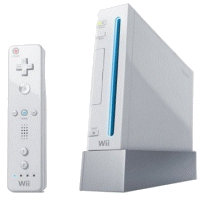 9. The Wii Generation (circa 2005 to 2012)
-- got started with Microsoft releasing its X-Box 360 game
system in the fall of 2005, and Sony's Playstation 3 and
Nintendo's Wii in late 2006. So far the only known innovations
introduced in this newborn generation of videogames is the use
of Blu-Ray DVD technology in the Playstation 3, plus HDTV
compatibility for the Playstation 3 and X-Box 360, resulting in
sharper graphics for gameplay, and the Nintendo Wii's infrared
controller that reacts to physical movement of the remote-like
controller unit. Internet websurfing capabilities introduced by
the fledgling Sega Dreamcast would become a standard feature for
all three systems, with downloadable games and additional
content for existing games being offered. The marketing of the game systems would eventually
be split into the "casual game market" and the "hardcore game
market" as the Wii offered games that appealed to a broader base
of potential players while the Playstation 3 and X-Box 360
offered games that appealed to the same demographic of gamers as
Sony's and Microsoft's previous generation's systems. Due to
being in second and third place behind Nintendo in system sales,
Sony and Microsoft were also aiming to grab the share of the
same market with their motion-sensing control devices such as
the Playstation Move and the Kinect for the X-Box 360.
9. The Wii Generation (circa 2005 to 2012)
-- got started with Microsoft releasing its X-Box 360 game
system in the fall of 2005, and Sony's Playstation 3 and
Nintendo's Wii in late 2006. So far the only known innovations
introduced in this newborn generation of videogames is the use
of Blu-Ray DVD technology in the Playstation 3, plus HDTV
compatibility for the Playstation 3 and X-Box 360, resulting in
sharper graphics for gameplay, and the Nintendo Wii's infrared
controller that reacts to physical movement of the remote-like
controller unit. Internet websurfing capabilities introduced by
the fledgling Sega Dreamcast would become a standard feature for
all three systems, with downloadable games and additional
content for existing games being offered. The marketing of the game systems would eventually
be split into the "casual game market" and the "hardcore game
market" as the Wii offered games that appealed to a broader base
of potential players while the Playstation 3 and X-Box 360
offered games that appealed to the same demographic of gamers as
Sony's and Microsoft's previous generation's systems. Due to
being in second and third place behind Nintendo in system sales,
Sony and Microsoft were also aiming to grab the share of the
same market with their motion-sensing control devices such as
the Playstation Move and the Kinect for the X-Box 360.
A new trend that emerged near
the end of this generation was "crowdfunding" independent
developer gaming projects, where money for developing a
videogame would come not from a publisher or an investor, but
from the people themselves who would be interested in seeing the
project come to fruition. One of these "crowdfunded" projects
was the release of an online gaming system known as the Ouya.
10. The "Eighth
Generation" (2012 to 2020?) -- features again the three
big game system manufacturers making successor systems, with the
first being Nintendo's Wii U, which not only brings their
audiovisual quality of gaming up to Xbox 360 levels, but also
offers a unique tablet controller for games that will use it.
Sony and Microsoft's systems, the Playstation 4 and the Xbox
One, came a year later, pushing the quality of graphics fidelity
even further while adding other home entertainment
possibilities. In the handheld game
department, Nintendo brought out the 3DS while Sony brought out
the Playstation Vita, both of which were competing against
tablets and smartphones for ownership. Both the Wii U and the
3DS would later be replaced by the hybrid console/handheld
system called the Switch in 2017, which made console-quality
gaming be accessible whether at home or on the go.
Online
gaming devices such as the much-touted "Steam Machine" from
Valve and the Android-based microconsole systems such as the
Ouya and the Amazon Fire TV have attempted to compete against
the three major consoles, with varying results.
11. The
"Ninth Generation" (starting in 2020) -- will be kicked
off with the impending release of the Playstation 5 and the
Xbox Series X.
 1. The Pong Generation (early to
late 1970s) -- which brought forth the introduction of
videogaming in general to the American public, both in the
arcade and in the home. Ralph Baer's experiments with
broadcasting images from a computer board to a television became
successful enough to be used in the first videogame system
produced for the home market, the Magnavox Odyssey, which used
plastic screen overlays to supplement the rather crude graphics
of the system's built-in games. Nolan Bushnell used the
technology to develop the first arcade-based videogames,
Computer Space and Pong. The first game Computer
Space became a flop because it was too advanced of a game
for its time, but its follow-up Pong became such a
sensation that it inspired other similar games like Breakout
and Circus by Exidy. The company Atari was born
from the success of Pong, and eventually other companies
would be birthed either from out of nowhere or from the existing
manufacturers of pinball games, such as Bally's Midway, to
develop other arcade games. Self-contained game systems
that played variations of Pong and other sorts of games
that emerged in this generation would flood the market by the
mid-1970s.
1. The Pong Generation (early to
late 1970s) -- which brought forth the introduction of
videogaming in general to the American public, both in the
arcade and in the home. Ralph Baer's experiments with
broadcasting images from a computer board to a television became
successful enough to be used in the first videogame system
produced for the home market, the Magnavox Odyssey, which used
plastic screen overlays to supplement the rather crude graphics
of the system's built-in games. Nolan Bushnell used the
technology to develop the first arcade-based videogames,
Computer Space and Pong. The first game Computer
Space became a flop because it was too advanced of a game
for its time, but its follow-up Pong became such a
sensation that it inspired other similar games like Breakout
and Circus by Exidy. The company Atari was born
from the success of Pong, and eventually other companies
would be birthed either from out of nowhere or from the existing
manufacturers of pinball games, such as Bally's Midway, to
develop other arcade games. Self-contained game systems
that played variations of Pong and other sorts of games
that emerged in this generation would flood the market by the
mid-1970s. 2. The Atari
Generation Part I (late 1970s to early 1980s) -- came
about with the introduction of both the Atari 2600 Video
Computer System and Taito's arcade game Space Invaders,
both of which redefined video games in their own ways. The
Atari 2600 would introduce and popularize the concept of game
systems that would use interchangeable game programs contained
in cartridges, while Space Invaders brought forth a much
more modernized concept of gaming such as increasing challenge
with each new screen to conquer in addition to having only a few
lives to play a game with. These changes would inspire a
new generation of both arcade games and videogame systems that
would explore the possibilities inherent thereof. Atari's
Asteroids would use a different kind of video technology
as it would present a different kind of space game taking place
in a zero-gravity setting, allowing for more freedom of movement
than Taito's Space Invaders. Namco's Pac-Man
would introduce the "mascot game" where a familiar face would
become a flagship character associated with its parent company
(Midway for the American audiences) as it would spawn multiple
sequels featuring variations of both its character and its
gameplay.
2. The Atari
Generation Part I (late 1970s to early 1980s) -- came
about with the introduction of both the Atari 2600 Video
Computer System and Taito's arcade game Space Invaders,
both of which redefined video games in their own ways. The
Atari 2600 would introduce and popularize the concept of game
systems that would use interchangeable game programs contained
in cartridges, while Space Invaders brought forth a much
more modernized concept of gaming such as increasing challenge
with each new screen to conquer in addition to having only a few
lives to play a game with. These changes would inspire a
new generation of both arcade games and videogame systems that
would explore the possibilities inherent thereof. Atari's
Asteroids would use a different kind of video technology
as it would present a different kind of space game taking place
in a zero-gravity setting, allowing for more freedom of movement
than Taito's Space Invaders. Namco's Pac-Man
would introduce the "mascot game" where a familiar face would
become a flagship character associated with its parent company
(Midway for the American audiences) as it would spawn multiple
sequels featuring variations of both its character and its
gameplay. 3. The Atari Generation Part II (early 1980s to
1984) -- was a short-lived period that saw a technological
maturation in the home videogaming arena where companies such as
Coleco and Atari offered game systems that would bring
arcade-quality gaming home in the form of the ColecoVision and
the Atari 5200, respectively. Also in that period came
"multi-platform publishing" of games across various game systems
and personal computers, even from companies that sold competing
hardware for the software.
3. The Atari Generation Part II (early 1980s to
1984) -- was a short-lived period that saw a technological
maturation in the home videogaming arena where companies such as
Coleco and Atari offered game systems that would bring
arcade-quality gaming home in the form of the ColecoVision and
the Atari 5200, respectively. Also in that period came
"multi-platform publishing" of games across various game systems
and personal computers, even from companies that sold competing
hardware for the software. 4. The Crash (1984 to 1985) --
was the short period between the Atari Generation Part II and
the Nintendo Generation when the American home gaming market
fell to pieces. Lost profits from a glut of games with no
quality control present was one of the primary reasons for this
to happen, although another was that the American public simply
saw videogames as a passing fad and that time period being a
transitioning phase to embrace personal computers.
Companies that once dealt in videogames and game consoles either
went out of business or shifted their marketing strategies
toward personal computer hardware and software. Even
computer companies with their respective personal computer
systems were dying off, leaving only Atari, Apple, Commodore,
IBM, and Tandy as active players. The Apple Macintosh, the
Commodore Amiga, and the Atari ST would emerge in those
troublesome times as the computers that would set the stage for
those that would follow in the coming generations.
4. The Crash (1984 to 1985) --
was the short period between the Atari Generation Part II and
the Nintendo Generation when the American home gaming market
fell to pieces. Lost profits from a glut of games with no
quality control present was one of the primary reasons for this
to happen, although another was that the American public simply
saw videogames as a passing fad and that time period being a
transitioning phase to embrace personal computers.
Companies that once dealt in videogames and game consoles either
went out of business or shifted their marketing strategies
toward personal computer hardware and software. Even
computer companies with their respective personal computer
systems were dying off, leaving only Atari, Apple, Commodore,
IBM, and Tandy as active players. The Apple Macintosh, the
Commodore Amiga, and the Atari ST would emerge in those
troublesome times as the computers that would set the stage for
those that would follow in the coming generations. 5. The Nintendo
Generation (1985 to late 1980s) -- saw what could be
termed "The Great Videogame Revival" as two arcade game
manufacturers, Nintendo and Sega, brought the hobby and industry
back to life in America with the NES and Sega Master
System. The systems and the games that eventually were
made for them would help prove to America that videogaming was
more than a fad or a transitional stage to using computers; it
was a way of life. Just as merchandising related to
videogames of the early 1980s erupted back then, with prominent
characters such as Pac-Man and Donkey Kong
being primary cash cows in that regard, similar merchandising
would revolve around games made for the NES and characters like
Mario and Legend Of Zelda's Link. Books and
magazines would again be written about videogames of this new
generation. Movies like The Wizard would again
spread the message of the joys of videogaming, which would lead
into the 1990s glut of movies based on videogame titles such as
Super Mario Bros. and Mortal Kombat.
5. The Nintendo
Generation (1985 to late 1980s) -- saw what could be
termed "The Great Videogame Revival" as two arcade game
manufacturers, Nintendo and Sega, brought the hobby and industry
back to life in America with the NES and Sega Master
System. The systems and the games that eventually were
made for them would help prove to America that videogaming was
more than a fad or a transitional stage to using computers; it
was a way of life. Just as merchandising related to
videogames of the early 1980s erupted back then, with prominent
characters such as Pac-Man and Donkey Kong
being primary cash cows in that regard, similar merchandising
would revolve around games made for the NES and characters like
Mario and Legend Of Zelda's Link. Books and
magazines would again be written about videogames of this new
generation. Movies like The Wizard would again
spread the message of the joys of videogaming, which would lead
into the 1990s glut of movies based on videogame titles such as
Super Mario Bros. and Mortal Kombat. 6. The 16-Bit Generation (late
1980s to mid-1990s) -- got its start with Sega jumping the
gun ahead of Nintendo through the release of the Genesis system
two years before the Super NES, and through NEC making its
attempt to break into the market with its TurboGrafx-16.
All three of these systems would show forward-thinking progress
with graphics and sound capabilities that surpassed what the
previous generation of game systems could come up with, while
only two of them, the Genesis and the TurboGrafx-16, would go
further by introducing CD-ROM attachments that would bolster the
amount of memory the system could read in order to create bigger
and (hopefully) longer-playing games. Unfortunately, they
would end up being mostly used for full-motion video games that,
for one, are not suited for the technology of the time and, for
another, would wind being just as repetitive to play and less
interactive as their predecessors in the arcade nearly a decade
ago.
6. The 16-Bit Generation (late
1980s to mid-1990s) -- got its start with Sega jumping the
gun ahead of Nintendo through the release of the Genesis system
two years before the Super NES, and through NEC making its
attempt to break into the market with its TurboGrafx-16.
All three of these systems would show forward-thinking progress
with graphics and sound capabilities that surpassed what the
previous generation of game systems could come up with, while
only two of them, the Genesis and the TurboGrafx-16, would go
further by introducing CD-ROM attachments that would bolster the
amount of memory the system could read in order to create bigger
and (hopefully) longer-playing games. Unfortunately, they
would end up being mostly used for full-motion video games that,
for one, are not suited for the technology of the time and, for
another, would wind being just as repetitive to play and less
interactive as their predecessors in the arcade nearly a decade
ago. 7. The Playstation
Generation (mid- to late 1990s) -- saw another
technological jump, both from using cartridges to using CD-ROMs
as the main source of gaming storage, and from flat 2D "sprite"
images to 3D-rendered polygons. Sega and Sony went into
this generation with the systems that would use both
technologies, the Saturn and the Playstation, while Nintendo
balked at the idea of using CD-ROMs due to perceived piracy and
instead resorted to cartridges for their Nintendo 64.
Square, the role-playing videogame developer for Nintendo's
systems, would end up releasing Final Fantasy VII for
the Playstation instead of the Nintendo 64, using that system's
strengths to its advantage. Undaunted by the loss,
Nintendo upgraded its long-running Super Mario and Legend
Of Zelda game series to being full-fledged 3D adventures
while improving on the emerging first-person shooter category
with an adaptation of MGM/UA's Goldeneye from the James
Bond series of movies.
7. The Playstation
Generation (mid- to late 1990s) -- saw another
technological jump, both from using cartridges to using CD-ROMs
as the main source of gaming storage, and from flat 2D "sprite"
images to 3D-rendered polygons. Sega and Sony went into
this generation with the systems that would use both
technologies, the Saturn and the Playstation, while Nintendo
balked at the idea of using CD-ROMs due to perceived piracy and
instead resorted to cartridges for their Nintendo 64.
Square, the role-playing videogame developer for Nintendo's
systems, would end up releasing Final Fantasy VII for
the Playstation instead of the Nintendo 64, using that system's
strengths to its advantage. Undaunted by the loss,
Nintendo upgraded its long-running Super Mario and Legend
Of Zelda game series to being full-fledged 3D adventures
while improving on the emerging first-person shooter category
with an adaptation of MGM/UA's Goldeneye from the James
Bond series of movies. 8. The X-Box Generation (late
1990s to circa 2005) -- saw both graphical improvements in
the 3D gaming pioneered by its previous generation and the
switch from using CD-ROMs to DVD-ROMs in three of the four game
systems that were released: the Dreamcast, the Playstation 2,
the X-Box, and the Gamecube. The systems would also make
online gaming, only touched upon by the Super NES and the
Genesis through the X-Band modem, much more commonplace.
8. The X-Box Generation (late
1990s to circa 2005) -- saw both graphical improvements in
the 3D gaming pioneered by its previous generation and the
switch from using CD-ROMs to DVD-ROMs in three of the four game
systems that were released: the Dreamcast, the Playstation 2,
the X-Box, and the Gamecube. The systems would also make
online gaming, only touched upon by the Super NES and the
Genesis through the X-Band modem, much more commonplace. 9. The Wii Generation (circa 2005 to 2012)
-- got started with Microsoft releasing its X-Box 360 game
system in the fall of 2005, and Sony's Playstation 3 and
Nintendo's Wii in late 2006. So far the only known innovations
introduced in this newborn generation of videogames is the use
of Blu-Ray DVD technology in the Playstation 3, plus HDTV
compatibility for the Playstation 3 and X-Box 360, resulting in
sharper graphics for gameplay, and the Nintendo Wii's infrared
controller that reacts to physical movement of the remote-like
controller unit. Internet websurfing capabilities introduced by
the fledgling Sega Dreamcast would become a standard feature for
all three systems, with downloadable games and additional
content for existing games being offered. The marketing of the game systems would eventually
be split into the "casual game market" and the "hardcore game
market" as the Wii offered games that appealed to a broader base
of potential players while the Playstation 3 and X-Box 360
offered games that appealed to the same demographic of gamers as
Sony's and Microsoft's previous generation's systems. Due to
being in second and third place behind Nintendo in system sales,
Sony and Microsoft were also aiming to grab the share of the
same market with their motion-sensing control devices such as
the Playstation Move and the Kinect for the X-Box 360.
9. The Wii Generation (circa 2005 to 2012)
-- got started with Microsoft releasing its X-Box 360 game
system in the fall of 2005, and Sony's Playstation 3 and
Nintendo's Wii in late 2006. So far the only known innovations
introduced in this newborn generation of videogames is the use
of Blu-Ray DVD technology in the Playstation 3, plus HDTV
compatibility for the Playstation 3 and X-Box 360, resulting in
sharper graphics for gameplay, and the Nintendo Wii's infrared
controller that reacts to physical movement of the remote-like
controller unit. Internet websurfing capabilities introduced by
the fledgling Sega Dreamcast would become a standard feature for
all three systems, with downloadable games and additional
content for existing games being offered. The marketing of the game systems would eventually
be split into the "casual game market" and the "hardcore game
market" as the Wii offered games that appealed to a broader base
of potential players while the Playstation 3 and X-Box 360
offered games that appealed to the same demographic of gamers as
Sony's and Microsoft's previous generation's systems. Due to
being in second and third place behind Nintendo in system sales,
Sony and Microsoft were also aiming to grab the share of the
same market with their motion-sensing control devices such as
the Playstation Move and the Kinect for the X-Box 360.